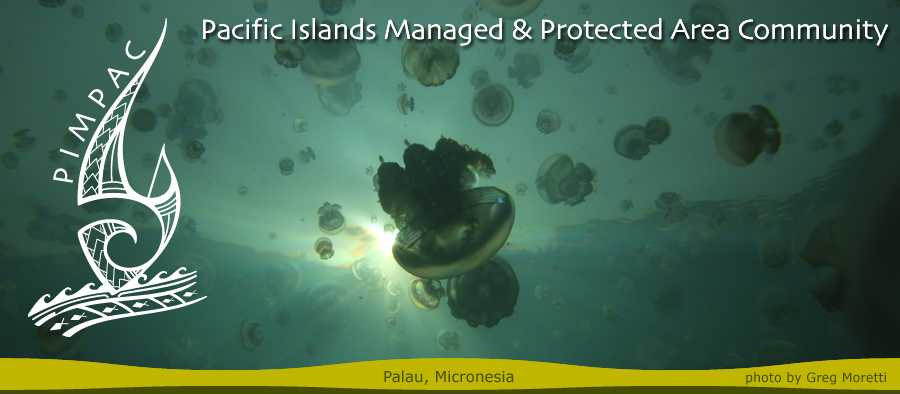
PIMPAC SCOPE PIMPAC targets capacity building for effective site-based management. It was recognized by the group that site-based management cannot achieve all resource management goals alone and must be integrated into larger frameworks. As such, at the site level, PIMPAC will also support ecosystem-based management approaches, which integrate land and sea connections as well as human dimensions into management planning and activities. Examples of this scope include ridge to reef management, marine and/or terrestrial protected areas, and community based locally managed areas. PIMPAC MISSIONThe Pacific Islands Managed and Protected Area Community (PIMPAC) aims to provide continuous opportunities for the sharing of information, expertise, practice, and experience to develop and strengthen site-based and ecosystem-based management capacity throughout the Pacific Islands region. PIMPAC AUDIENCEPIMPAC will focus on support to “on the ground” site-based resource managers, and maintain good coordination/communication with other networks/agencies that focus support to political/organizational leaders (e.g. MC/USCRTF/MIC) or community members (e.g. local NGOs, municipal agencies, LMMA Network, etc.). PIMPAC ApproachAs a social network, PIMPAC uses four main approaches to carry out it’s mission. They are: 1) Training and Technical Support, 2) Learning Exchanges, 3) Partnership Building, and 4) Communications/ Information Sharing History of PIMPAC and Regional Context The Pacific Islands Managed and Protected Area Community (PIMPAC) began in 2005 as a pilot program to identify and address the unique set of challenges faced by Marine Protected Area (MPA) managers in the region. These challenges include limitations in human and financial resources, isolation from one another restricting the ability of managers to learn from and apply approaches that have been successful elsewhere, and building on traditional management approaches while adapting to modern technology and practices. To overcome these challenges, more than 45 MPA leaders from around the Pacific Islands (US flag islands, Freely Associated States, and Fiji) met in Tumon, Guam from August 26 to 31, 2005 to explore ways of working together to increase the effectiveness of MPA management. The participants shared a common vision for a regional social network that would strengthen their individual and collective MPA efforts. They committed to work together through this evolving regional Pacific Islands MPA Community. Participants also agreed that the aim of PIMPAC would be to provide a continuous forum for: 1) training and technical support around priority topic areas, 2) learning exchanges among their peers, 3) partnership building that would foster increased and long term support and capacity building, and 4) information sharing of lessons learned and opportunities. To implement this pilot program, the US National Oceanic and Atmospheric Administration (NOAA) Coral Reef Conservation Program committed to three years of program funding and coordination support. The University of Guam, Marine Lab, also provided coordination support for PIMPAC for two years. Shortly thereafter, the Department of Interior (DOI), Office of Insular Affairs committed further funding for additional regional coordination and project implementation. Because PIMPAC has mainly funded through US government support, the focus of these efforts has been to US Flag Islands and the Freely Associated States. Since 2006, PIMPAC has been evolving and adapting to fulfill its regional aims and meet local partner needs. A three year strategic plan was developed to focus PIMPAC support and provide clear understanding on the approach of PIMPAC efforts. During these first years of PIMPAC, training efforts were focused on MPA management planning and community/stakeholder engagement to build a foundation for future technical support efforts on other priority topics such as, monitoring, enforcement, outreach, and sustainable funding. PIMPAC also has focused efforts on sharing information (updates, opportunities, lessons) among partners, offering learning exchanges, and supporting youth involvement in MPA efforts. Finally, PIMPAC has aimed at supporting national and regional efforts to develop networks of effective marine protected areas. These efforts include the US Coral Reef Task Force, the Micronesia Challenge, and the U.N. Convention on Biological Diversity Programme of Work on Protected Areas. Additionally, PIMPAC intends to expand efforts to include Western Samoa through the new “Two Samoa’s” Initiative, as well as other Pacific Countries interested in collaborating. |
MORE INFORMATION2005 Pre-PIMPAC Outreach Results 2010-2012 PIMPAC Strategic Plan 2015 PIMPAC Internal Assessment_final PIMPAC Strategic Plan_2013-16 final FINAL_PIMPAC Strategic Plan 2017_Full_Version     |
| © PIMPAC |
| web design by AI Design Studio |